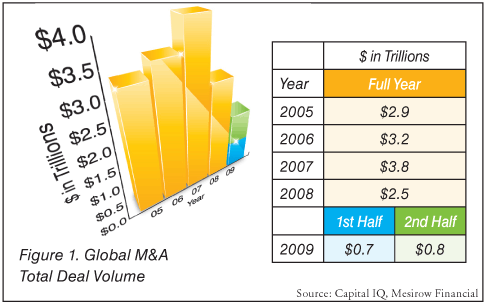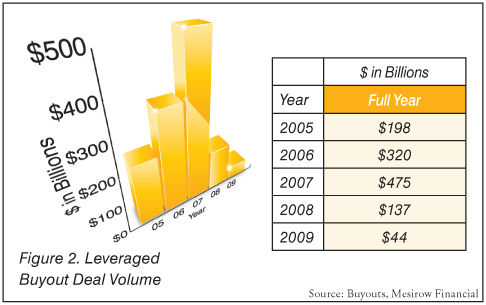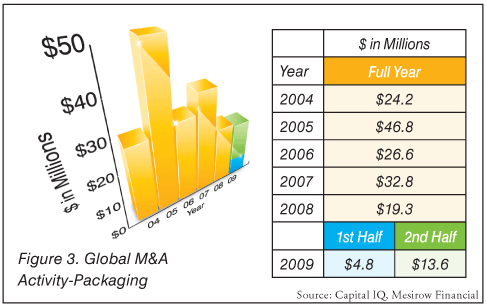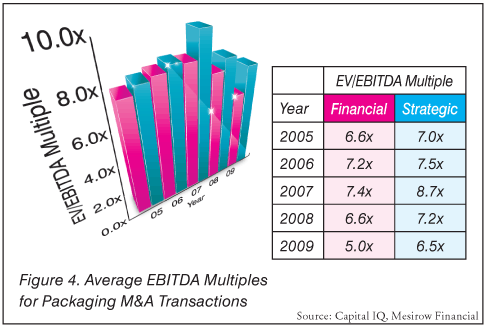2010 Year of Recovery
- Published: January 01, 2010, By By Bill Hornell and John Chrysikopoulos, Mesirow Financial
The first half of 2009 witnessed the trough of a powerful recession that cut a wide swath through some of our nation's largest industries. Housing, autos, financial services, travel, food service, luxury goods, apparel, and commercial real estate all were affected significantly by the continued undertow of declining demand. The human toll from this recession is most evident in our country's staggering unemployment numbers. It will take years before our payrolls return to the peak levels seen in 2007.
As this article is written, the economy is recovering. The natural economic cycle in conjunction with global monetary and fiscal stimulus have joined forces to re-inflate demand. Companies are tepidly hiring again; the stock market has recovered from its lows; and consumer confidence is improving. However, large questions remain: Will the US government and the Federal Reserve be able to execute an exit plan from its oversized role in final demand? Will the US be able to stop its slide in global economic market share? How significant will the negative impact of high, chronic unemployment be on economic growth?
The merger and acquisition (M&A) market in 2009 reflected the economic pattern described here. The first half of the year witnessed a slide in M&A activity to levels not seen in years. The second half of the year saw improvement, but it was spotty (with paper and packaging actually being a bright spot). However, leveraged buyout M&A activity remained moribound.
Figure 1 demonstrates the significant drop in global merger and acquisition activity across all industries.

A severe contraction in M&A activity is not at all surprising given the head-winds virtually all companies faced in 2008 and 2009: drops in demand, pressure on profits, lower public market valuations, and scarcity of credit. No wonder CEOs took a low profile in the M&A game.
Even more startling is the drop in leveraged buyout activity depicted in Figure 2.

Leveraged buyouts are very dependent on the availability of high risk credit. That type of credit was almost non-existent in the first half of 2009 but did show some signs of re-emergence in the second half. However, it will probably take a new generation of credit providers to emerge before the levels of 2007 are approached again.
The packaging industry was not immune to the economic challenges seen in 2009. Several of the industry's titans saw their stock prices and valuations tumble in the first half of the year. However, with the faltering economy came lower input costs and a commensurate boost to operating margins. In addition, packaging producers took a disciplined approach to mill and plant operating rates. This discipline, in conjunction with reasonable levels of end market demand, resulted in improvements in profits and stock valuations in the second half of 2009.
The relative strength of the packaging industry can be seen in the M&A statistics. Figure 3 shows packaging M&A volume picked up noticeably in the second half of the year.

The totals were supported by such noteworthy transactions as the purchase of Alcan's pharmaceutical packaging business by Amcor, the purchase of Alcan's flexible packaging business by Bemis, and the purchase of Specialized Packaging Group by PaperWorks Industries (Mesirow advised Specialized Packaging Group in this transaction). While not affecting M&A totals, it also should be noted that 2009 witnessed several significant paper and packaging bankruptcies: Smurfit-Stone, Pliant, AbitibiBowater, Caraustar, and Fraser Papers, for example.
Not surprisingly, packaging deal volume could not escape the slowdown in private equity-led activity. In a typical year, private equity transactions account for roughly half of all packaging deals. In 2009, only 25% of the deals were backed by private equity groups, and only one exceeded $500 million in value.
The combination of significant declines in share prices, public market valuations, and reduced M&A volume led to a drop in purchase price multiples. Figure 4 compares valuation multiples for both strategic and financial buyers over the past few years.

Outlook for 2010
Mesirow Financial is expecting improvement in the merger and acquisition marketplace in 2010. Much of the improvement will be driven by strategic buyers whose confidence levels have benefited from the following:
- Increased stock prices (A Mesirow index of paper and packaging market capitalizations has increased by 230% from the lows seen in March 2009.)
- Increased levels of corporate liquidity and access to the debt markets
- An improving economy (Mesirow's chief economist is calling for a 3.1% increase in GDP in 2010.)
Continue on Next Page
For private equity buyers, 2010 will be a year of recovery. They have hundreds of billions of equity dollars to invest. The key to their activity will be the willingness on the part of debt providers to lend into leveraged transactions. Our view is that the profit opportunities in 2010 will be large enough for lenders in leveraged transactions so that they will elect to slowly increase their participation.
Bill Hornell is a managing director in the Investment Banking Group at Mesirow Financial, Chicago, IL. He has completed more than 70 packaging merger and acquisition transactions. A significant majority of these transactions involved consumer packaging businesses. Contact him at 312-595-6176 or at This email address is being protected from spambots. You need JavaScript enabled to view it.; www.mesirowfinancial.com.
Managing director John Chrysikopoulos joined Mesirow Financial in 2009. He has 14 years of investment banking experience, nine years of equity research experience, and has participated in numerous high profile paper and packaging transactions. Located in New York, he can be reached at 212-351-8181 or at This email address is being protected from spambots. You need JavaScript enabled to view it..
Weighing In…
“This past year has been one of tremendous opportunity for the paperboard packaging industry. While some individual companies experienced the effects from the recession, as a whole we continue to build on our long history of innovation and creativity to find new ways to do business better. The inherent sustainability of our products ensures that paperboard is the future's purest, most responsible packaging, and our industry is poised to adapt to and excel on the road ahead.” — Ben Markens, president, Paperboard Packaging Council
Weighing In…
“The outlook for the US flexible packaging industry is very promising, and there is growing optimism arising from the anticipated economic recovery. While all packaging segments are feeling some squeeze between the volatility in material costs and customer needs, flexible packaging is very well positioned. The optimism in the flexible packaging industry is supported by innovations which are meeting consumer convenience demands and the industry's sustainability advantages, including the use of fewer resources and generation of less greenhouse gas emissions. In 2010, the US flexible packaging industry is expected to grow by about 3% to $26.7 billion. This growth continues to outpace GDP.” — Marla Donahue, president, Flexible Packaging Assn.
Weighing In…
“I am optimistic for 2010-2013. TAPPI is just coming off our second year in a row in the black, after 11 straight years of red ink. Flexible packaging is expected to increase 3.5% year over year to 2013. Specific grades of paper in the digital, printing, and writing segments are expected to increase by 10.3% by 2013 over 2008 figures. Total specialty grades are projected to show a 3.7% increase, and paper used in flexible packaging is expected to increase by 2.4% over the same time period. With all the negative press that we hear on a daily basis, our industry is still hiring engineers to backfill for the retirement tsunami that we are experiencing in our industry.” — Larry Montague, president, TAPPI
Weighing In…
“Entering into 2010 marks a critical time for our industry as narrow web converters continue to persevere through the shifting landscape of the global economy and the maturation of the narrow web converting marketplace. Issues like customer demands, credit markets, interest rates, and raw material pricing continue to be paramount for TLMI members as converters strive to become more productive, more resourceful, and more innovative.” — Frank Sablone, president, Tag & Label Mfrs. Inst. (TLMI)
Weighing In…
“After consecutive months of unprecedented pessimism seen in our Economic Index of member companies in 2009, the third quarter report shows that there is renewed optimism for 2010. We expect the fourth quarter report to show similar findings — indicating that most feel the worst is behind us.” — Craig Sheppard, executive director, Assn. of Industrial Metallizers, Coaters and Laminators (AIMCAL).
Weighing In…
“Now it's your turn. Will 2010 bring much-needed relief to the converting industry? Visit my blog, “Yo's Yarns,” at www.pffc-online.com to weigh in.” — Yolanda Simonsis, associate publisher/editor, PFFC




